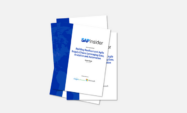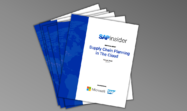SAP Supply Chain Planning
Filter By
Browse By
- SAP Analytics and AI
- SAP Application Development and Integration
- All SAP Application Development and Integration
- SAP ABAP
- SAP ABAP Development Tools
- SAP ABAP Test Cockpit
- SAP API Management
- SAP BAPI
- SAP Basis
- SAP BRF
- SAP Business Application Studio
- SAP CMS
- SAP Design Studio
- SAP Development Tools
- SAP DevOps
- SAP EAI
- SAP EDI
- SAP Extension Suite
- SAP Fiori
- SAP Fiori Elements
- SAP Integration Suite
- SAP Low Code Application Development
- SAP Low Code Automation
- SAP Netweaver
- SAP Release Management
- SAP UI5
- SAP Web Application Server
- SAP Web IDE
- SAP Business Process Management
- SAP Center of Excellence
- SAP CIO
- SAP Customer Experience
- SAP Data and Data Management
- All SAP Data and Data Management
- SAP BW
- SAP BW/4HANA
- SAP Crystal Reporting
- SAP Data Archiving
- SAP Data Center
- SAP Data Governance
- SAP Data Integration
- SAP Data Migration
- SAP Data Quality
- SAP Data Services
- SAP Data Strategy
- SAP Data Visualization
- SAP Data Warehouse Cloud
- SAP DMS
- SAP Document Control
- SAP EIM
- SAP ETL
- SAP ETL Tools
- SAP HANA
- SAP HANA Administration
- SAP HANA Deployment Infrastructure
- SAP HANA Studio
- SAP Master Data
- SAP Master Data Governance
- SAP MDM
- SAP Enterprise Architect
- SAP Enterprise Asset Management
- SAP ERP
- SAP Finance
- All SAP Finance
- SAP Accounting
- SAP AR AP
- SAP Asset Accounting
- SAP Billing Systems
- SAP BPC
- SAP BRIM
- SAP Cash Management
- SAP Central Finance
- SAP Controlling
- SAP COPA
- SAP Cost Center Accounting
- SAP e-invoicing
- SAP FICO
- SAP Finance Automation
- SAP Financial Closing Cockpit
- SAP Financial Consolidation
- SAP Financial Planning
- SAP FX Risk
- SAP General Ledger
- SAP Global Tax Management
- SAP Hyperion
- SAP Order to Cash
- SAP Payment Processing
- SAP Profitability Analysis
- SAP Rebate Management
- SAP S/4HANA Finance
- SAP Universal Journal
- SAP Governance Risk and Compliance
- SAP Human Capital Management
- SAP Intelligent Technologies
- SAP Platform and Technology
- All SAP Platform and Technology
- SAP Business Technology Platform
- SAP Cloud Connector
- SAP Cloud Integration Platform
- SAP Cloud Migration
- SAP Cloud Platform
- SAP Cloud Providers
- SAP Cloud Strategy
- SAP Container Platform
- SAP Digital Asset Management
- SAP Digital Integration Hub
- SAP Digital Signature
- SAP HANA Enterprise Cloud
- SAP HEC
- SAP Hyperscalers
- SAP Infrastructure
- SAP Messaging
- SAP Smart Forms
- SAP Quality and Testing
- SAP Security
- SAP Spend Management
- SAP Supply Chain Management
- All SAP Supply Chain Management
- SAP APO
- SAP Asset Management
- SAP Business Network
- SAP Digital Manufacturing Cloud
- SAP Digital Twin
- SAP EWM
- SAP IBP
- SAP Inventory Management
- SAP Label Printing
- SAP Logistics
- SAP Manufacturing
- SAP Manufacturing Automation
- SAP MES
- SAP MII
- SAP MM
- SAP MRO
- SAP MRP
- SAP Order Management
- SAP Plant Maintenance
- SAP PLM
- SAP Production Planning
- SAP S&OP
- SAP SD
- SAP SPM
- SAP Supply Chain Planning
- SAP Track and Trace
- SAP Transportation Management
- SAP System Administration
Supply Chain Management: SAP Supply Chain Planning
The art of orchestrating supply chain planning can be intricate. Unforeseen changes in supply, demand, and market changes are a test in agility. The ability to synchronize planning for sustainable growth is the key to building a resilient supply chain.
Supply Chain Planning Defined
Supply chain planning (SCP) is a forward-looking process. It is coordinating assets to optimize the delivery of goods, services, and information from suppliers to consumers. Organizations can leverage solutions to help navigate the complexities of planning and orchestrating supply chain operations flawlessly. SAP Integrated Business Planning (IBP) is powered by SAP S/4HANA memory and is a cloud-based planning software for supply chain management. IBP is a process for aligning a company’s business goals across operational functional areas.
Supply Chain Management: SAP Supply Chain Planning
The art of orchestrating supply chain planning can be intricate. Unforeseen changes in supply, demand, and market changes are a test in agility. The ability to synchronize planning for sustainable growth is the key to building a resilient supply chain.
Supply Chain Planning Defined
Supply chain planning (SCP) is a forward-looking process. It is coordinating assets to optimize the delivery of goods, services, and information from suppliers to consumers. Organizations can leverage solutions to help navigate the complexities of planning and orchestrating supply chain operations flawlessly. SAP Integrated Business Planning (IBP) is powered by SAP S/4HANA memory and is a cloud-based planning software for supply chain management. IBP is a process for aligning a company’s business goals across operational functional areas.
Key integration elements are:
- Supply and demand
- Finance and Operations
- Functions and business processes
- Strategy outcomes
- Non-financial measures
- Cash flow, costs, and revenues.
A structured process that comes from an IBP approach enables companies to make better informed and fact-based decisions. It provides planning, what-if scenario capabilities, and real-time demand commitments, considering constraints. Increased visibility enables companies to incorporate insights from supply chain projections, financial projects, and strategic plans. There are unmatched benefits of IBP for SAP Supply Chain Planning, like optimization of logistics, improved cross-functional collaboration, planning agility, risk mitigation, and improved forecast accuracy.
SAP Supply Chain Planning yields several benefits:
- Decreased costs
- Increased profits
- Reduction in delays
- Improved efficiency
- Increase in output
- Better cooperation.
Vendor partners that can offer software solutions or operational intelligence include – SAP, Reveal or Gib.
Key Considerations for SAPinsiders are:
- Video Q&A with Eric Jones from GIB on Connecting the Dots Between Supply Chain Planning and Execution. Learn how to tame many supply chain complexities with end-to-end -supply chain solutions by watching this video. The discussion gives a perspective on why supply chain planning tools are an imperative in today’s highly complex supply chains.
- Demand Planning Alerts Increase the Accuracy of your Forecasts. David Ducray explains that demand planners are often faced with converting large amounts of data into an accurate forecast. Review different ways to spot trends and errors in data by using alerts to help you create a more accurate forecast. Allow planners the ability to manage by exception.
- Meeting Demand with a Constrained Supply Using Product Allocation in SAP APO Global ATP. Alok Jaiswal reviews the process flow of how product allocation can be used in SAP Advanced Planning and Optimization (SAP APO). This utilizes global available-to-promise (ATP) to meet customer requirements by managing the supply of scarce products.
82 results
-

- SAP Supply Chain Planning
 Premium
Premium
Supply Chain GRC: Gain Control of Your Supply Chain Processes
June 14, 2023
Most companies want to grow their business as fast as possible, but they need stay in control of their supply chain process and avoid unnecessary risks. By implementing a Governance, Risk and Compliance (GRC) system, organizations can monitor processes and ensure they are defined, managed, planned, and executed correctly. Recent SAPinsider benchmark research points to…
-

ifm Supply Chain for Planning and Execution Transformation
Reading time: 6 mins
Extending the core ERP capabilities with additional solution functionality can be approached in two ways, namely “add-on” and “add-in” solutions. When it comes to add-on solutions, integration of data, people, and processes is required, which can be a costly and time-consuming process. On the other hand, add-in solutions are natively embedded in the ERP system,…
-

Creating Value Through End-to-End Supply Chain Planning
Reading time: 6 mins
Increasing supply chain complexity, coupled with rapidly evolving customer demand, has given rise to a set of challenges supply chain leaders have not encountered before. What extenuates these challenges for many organizations is the siloed approach to planning and tackling supply chain challenges.
-
-

- SAP Supply Chain Planning
 Premium
Premium
Webinar: Building Resilient and Agile Supply Chains Leveraging Data, Analytics and Automation
April 18, 2023
Supply chain challenges and associated risks are growing exponentially. These challenges surface in many forms, like unprecedented fluctuations in demand and supply, sudden disruptions impacting sourcing, manufacturing, and distribution, a proliferation of product offerings, and geopolitical and regulatory changes. These challenges have only intensified during the pandemic. As businesses evolve their supply chains to address…
-

- SAP Supply Chain Planning
 Premium
Premium
Generative AI for Supply Chain Data Management
Reading time: 5 mins
The frenzy around ChatGPT has stabilized for the millions of experimental end-users. However, the game has just begun for the technology giants who will now be competing in this space. The generative AI space will be highly competitive, but the competition will come from something other than product differentiation. Whether it is ChatGPT, BARD, or…
-

- SAP Supply Chain Planning
 Premium
Premium
Building Resilient and Agile Supply Chains Leveraging Data, Analytics and Automation
Reading time: 3 mins
Supply chain challenges and associated risks are growing exponentially. These challenges surface in many forms, like unprecedented fluctuations in demand and supply, sudden disruptions impacting sourcing, manufacturing, and distribution, a proliferation of product offerings, and geopolitical and regulatory changes. These challenges have only intensified during the pandemic. As businesses evolve their supply chains to address…
-

- SAP Supply Chain Planning
 Premium
Premium
Supply Chain Planning in the Cloud
October 04, 2022
As the magnitude of challenges that supply chains face today increases in magnitude exponentially, the importance of having best-of-breed supply chain planning capabilities has increased many-fold. As organizations scramble to digitally transform their supply chains to align with the volatility they face today, supply chain planning capabilities have developed from being a portfolio of tools…...…
-
-

- SAP Supply Chain Planning
 Premium
Premium
Access Digital Supply Chain 2022 Summit Presentations
Download presentations for the SAPinsider 2022 Supply Chain Summit to learn from peer case study presentations, workshops, roundtables, solution previews, and more. This content is for SAPinsider Monthly Subscription, SAPinsider Annual Subscription, and SAPinsider Premium Annual Subscription members only.Log In Join Now
-

- SAP Supply Chain Planning
 Premium
Premium
Supply Chain Planning in The Cloud for EMEA
Reading time: 1 mins
Supply chain planning capabilities have evolved from a portfolio of tools and technologies used to run and plan supply chain operations to a set of capabilities that can be leveraged to build business agility and resiliency in today's complex business environment. SAPinsiders have indicated in previous research, like, Analytics in The Cloud, that cloud can…
-

- SAP Supply Chain Planning
 Premium
Premium
Data Outliers Detection in SAP IBP Demand Forecasting
Reading time: 2 mins
In our recent research, Supply Chain Planning in The Cloud, SAPinsiders highlighted that demand forecasting remains a key challenge. Fortunately, best-of-breed supply chain tools today provide many features and functionalities, including a rich portfolio of algorithms, that can help bring more science and certainty into this exercise. However, as the popular saying of "Garbage-In-Garbage-Out (GIGO)"…
Featured Insiders
-

S V Prasad Gandhikota
Senior Systems Analyst, Conagra Brands
-

Laz Uriza
Business & Sales Strategy Director - WW SAP on Azure Strategy Lead
Global Sales & Strategy Lead, Microsoft
-

Biswaranjan Senapati
Capitol Technology University
Become a Member
Unlimited access to thousands of resources for SAP-specific expertise that can only be found here.
Upcoming Events
Related Vendors
Your request has been successfully sent

